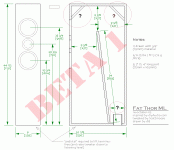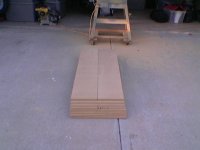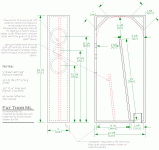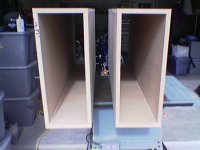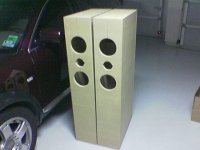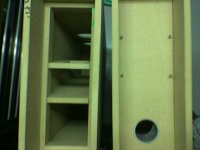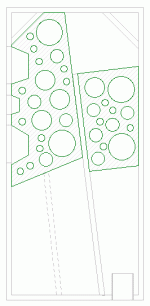Hello All,
Today a friend and I began the project by cutting the wood.
While reviewing the drawings, a few questions arose. For reference see the three (3) circled areas of the attached image.
1. What are the measurements for the two "path bend/turn" pieces?
2. What is the distance from the bottom of the center divider to the front or rear of the cabinet?
3. Any thoughts about shelf braces?
a. Where should the bracing be placed?
b. What thickness should the brace be (3/4")?
b. Size and number of holes in the brace.
My friend seems to feel we need to add one, possibly two shelf braces per speaker (one in the front chamber, and maybe another in the rear). How will this affect the speaker, if at all? Any suggestions regarding bracing will be much appreciated.
Thanks in advance for any information provided.
Regards,
Rep
P.S. Dave, if possible would you mind updating your drawings to include this data?
Today a friend and I began the project by cutting the wood.
While reviewing the drawings, a few questions arose. For reference see the three (3) circled areas of the attached image.
1. What are the measurements for the two "path bend/turn" pieces?
2. What is the distance from the bottom of the center divider to the front or rear of the cabinet?
3. Any thoughts about shelf braces?
a. Where should the bracing be placed?
b. What thickness should the brace be (3/4")?
b. Size and number of holes in the brace.
My friend seems to feel we need to add one, possibly two shelf braces per speaker (one in the front chamber, and maybe another in the rear). How will this affect the speaker, if at all? Any suggestions regarding bracing will be much appreciated.
Thanks in advance for any information provided.
Regards,
Rep
P.S. Dave, if possible would you mind updating your drawings to include this data?
Attachments
Repute said:1. What are the measurements for the two "path bend/turn" pieces?
2. What is the distance from the bottom of the center divider to the front or rear of the cabinet?
3. Any thoughts about shelf braces?
a. Where should the bracing be placed?
b. What thickness should the brace be (3/4")?
b. Size and number of holes in the brace.
I have updated the drawing with some more dimensions & notes. I've also added braces where i would put them. They should be filled with random holes until there is close to as much hole as not-hole. The major brace doesn't need to be full length -- the bit bracing the drivers to the rest of the cabinet is the most important bit.
My friend seems to feel we need to add one, possibly two shelf braces per speaker
no shelf braces please
<rant> shelf braces are probably the least effective braces you can use on any speaker</rant>
dave
Attachments
Thanks Dave. I appreciate the prompt reply. Will be working on them a bit more tomorrow.
Any preference as to the brace thickness? I know SCD suggested 1/2" some time back. Is this the recommended size? Are there disadvantages for using the thicker 3/4"?
I am not very versed in TL design, will the speaker need to be made wider to compensate the space used by the brace?
Regards,
Rep
Any preference as to the brace thickness? I know SCD suggested 1/2" some time back. Is this the recommended size? Are there disadvantages for using the thicker 3/4"?
I am not very versed in TL design, will the speaker need to be made wider to compensate the space used by the brace?
Regards,
Rep
Repute said:Any preference as to the brace thickness? I know SCD suggested 1/2" some time back. Is this the recommended size? Are there disadvantages for using the thicker 3/4"?
You are already using 3/4' so that is fine....
dave
Hello All
My friend Troy and I got alot complete today (Thanks Troy!). The speakers are assembled for the most part.
Not sure if we have the tools/expertise to make a central brace. How critial is the central brace? If it's very important, is there an easier alternative we can use?
We did add the "optional" brace Dave listed in his updated drawings.
In addition, we decided to make the bottom removable, to ease adding/adjusting stuffing the speaker (particularly the rear).
Thanks!
Rep
My friend Troy and I got alot complete today (Thanks Troy!). The speakers are assembled for the most part.
Not sure if we have the tools/expertise to make a central brace. How critial is the central brace? If it's very important, is there an easier alternative we can use?
We did add the "optional" brace Dave listed in his updated drawings.
In addition, we decided to make the bottom removable, to ease adding/adjusting stuffing the speaker (particularly the rear).
Thanks!
Rep
Attachments
Repute said:Not sure if we have the tools/expertise to make a central brace. How critial is the central brace? If it's very important, is there an easier alternative we can use?
The important thing is to brace the drivers (mounted on the weakest part of the box) to the middle partition, and the back of the box. The easy way -- what i'd do if i built them -- would be to do 2 braces (the sketch attached will give you an idea & shows what i'd consider a minimum).
dave
Attachments
I've been following this thread and it all sounds very interesting.
Is it possible to change the Fat-Thor design so the "port" is shaped like the original except located at the front down by the floor instead of top-rear as in the original design.
I'm no TL expert but every speaker I've heard with a down-facing port sounds **weird**..
Cheers
Is it possible to change the Fat-Thor design so the "port" is shaped like the original except located at the front down by the floor instead of top-rear as in the original design.
I'm no TL expert but every speaker I've heard with a down-facing port sounds **weird**..
Cheers
andrew01 said:I've been following this thread and it all sounds very interesting.
Is it possible to change the Fat-Thor design so the "port" is shaped like the original except located at the front down by the floor instead of top-rear as in the original design.
I'm no TL expert but every speaker I've heard with a down-facing port sounds **weird**..
Cheers
from an aesthetic standpoint, a down-facing port is easily plugged -- (no veneering necessary on the parts which remain hidden). If you have a sabre-saw to cut a new port on the front or rear you can change the design.
planet10 said:
The important thing is to brace the drivers (mounted on the weakest part of the box) to the middle partition, and the back of the box. The easy way -- what i'd do if i built them -- would be to do 2 braces (the sketch attached will give you an idea & shows what i'd consider a minimum).
dave
So 3/4" wood 9 inches wide glued and air nailed to the edge of a 20 inch deep 3/4" panel is going to flex?
The 20" panel has more chance of flexing than the 9" strip.
I don't pretend to be an expert, but has anyone built / measured the flex of these enclosures? I seriously doubt the front or rear panel are going to move anywhere as much as the sides.
Repute didn't mention that we strayed from the plans in the fact that he wanted the enclosures taller, so we left the wood 49" and made a false floor on the bottom.
His bottom facing port will now vent into a "chamber" open in the back. He can relocate the port to the lower back or leave it straight down(not open the lower rear of the chamber) and have his pedistal / stand open so the air vents through the bottom around his spikes.
It is a solid box.. I think his current Madisound enclosures (which are nice) will vibrate / flex more than theses.
rabstg said:So 3/4" wood 9 inches wide glued and air nailed to the edge of a 20 inch deep 3/4" panel is going to flex?
Where it has the big holes cut into it, it certainly will. As i said the purpose of those braces is to brace the drivers. Any benefits to the box are secondary fringe benefits.
dave
rabstg said:
I don't pretend to be an expert, but has anyone built / measured the flex of these enclosures? I seriously doubt the front or rear panel are going to move anywhere as much as the sides.
Not in this particular instance, but I recall that in the 1980's someone, in some magazine rigged a phono cartridge to the cabinet enclosure to measure the flexure -- (the cartridge was attached to one of the gadgets you use in the lab to hold a measurement device in place.
Now we will have to go back to our physics texts to calculate the springiness factors.
Finished assembling the second speaker late last night.
A quick listen did seem to reveal an improvement on the lower end. Will need to make some stuffing adjustments and critique them over the next few days.
Rapstg who helped me build the cabinets will be coming over later today to give them a listen.
Will keep everyone posted.
Regards,
Rep
A quick listen did seem to reveal an improvement on the lower end. Will need to make some stuffing adjustments and critique them over the next few days.
Rapstg who helped me build the cabinets will be coming over later today to give them a listen.
Will keep everyone posted.
Regards,
Rep
- Home
- Loudspeakers
- Multi-Way
- Clarity on Seas Thor Kit
